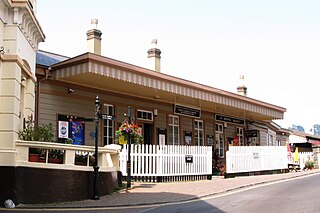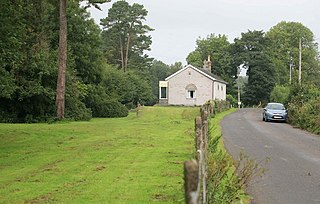
The Cornwall Railway was a 7 ft 1⁄4 in broad gauge railway from Plymouth in Devon to Falmouth in Cornwall, England, built in the second half of the nineteenth century. It was constantly beset with shortage of capital for the construction, and was eventually forced to sell its line to the dominant Great Western Railway.

The Bristol and Exeter Railway (B&ER) was an English railway company formed to connect Bristol and Exeter. It was built on the broad gauge and its engineer was Isambard Kingdom Brunel. It opened in stages between 1841 and 1844. It was allied with the Great Western Railway (GWR), which built its main line between London and Bristol, and in time formed part of a through route between London and Cornwall.
The Buckfastleigh, Totnes and South Devon Railway built the broad gauge railway line from Totnes to Buckfastleigh and Ashburton in Devon, England.
The North Devon Railway connected Barnstaple to the growing railway network in 1854 and as Ilfracombe developed as a watering place, it was obvious a railway connection to the town was needed. The hilly terrain was very difficult, but an Ilfracombe Railway was authorised in 1864 but failed when a major shareholder was unable to respond to a subscription call. After several false starts the Barnstaple and Ilfracombe Railway, soon taken over by the London and South Western Railway, opened in 1870.
The Wellington to Craven Arms Railway was formed by a group of railway companies that eventually joined the Great Western Railway family, and connected Wellington, Shropshire and Shifnal, with Coalbrookdale, Buildwas, Much Wenlock and a junction near Craven Arms. Its objectives were dominated by the iron, colliery and limestone industries around Coalbrookdale.

The Dartmouth and Torbay Railway was a broad gauge railway linking the South Devon Railway branch at Torquay with Kingswear in Devon, England. It was operated from the outset by the South Devon Railway.
The Carmarthen and Cardigan Railway was a 7 ft 1⁄4 in broad gauge railway line in Wales that was intended to connect Carmarthen on the South Wales Railway with Cardigan. In fact, it was unable to raise the necessary capital and was loss-making from the time of opening the first short section of its line in 1860, and it was in receivership for much of its life. It eventually reached Llandysul in 1864 but was not extended further during its independent existence.
The South Devon Railway Company built and operated the railway from Exeter to Plymouth and Torquay in Devon, England. It was a 7 ft 1⁄4 in broad gauge railway built by Isambard Kingdom Brunel.

The Exeter and Crediton Railway was a 7 ft broad gauge railway that linked Exeter and Crediton, Devon, England. It was 5¼ miles (8½ km) long.

The North Devon Railway was a railway company which operated a line from Cowley Bridge Junction, near Exeter, to Bideford in Devon, England, later becoming part of the London and South Western Railway's system. Originally planned as a broad gauge feeder to the Bristol & Exeter Railway, it became part of a battle between the broad gauge group and the standard gauge railway interests. In this context, standard gauge lines were often described as narrow gauge.
The Wilts, Somerset and Weymouth Railway (WS&WR) was an early railway company in south-western England. It obtained Parliamentary powers in 1845 to build a railway from near Chippenham in Wiltshire, southward to Salisbury and Weymouth in Dorset. It opened the first part of the network but found it impossible to raise further money and sold its line to the Great Western Railway (GWR) in 1850.
The Bristol and North Somerset Railway was a railway line in the West of England that connected Bristol with Radstock, through Pensford and further into northern Somerset, to allow access to the Somerset Coalfield. The line ran almost due south from Bristol and was 16 miles (26 km) long.
The Manchester and Milford Railway was a Welsh railway company, intended to connect Manchester and the industrial areas of North West England with a deep-water port on Milford Haven, giving an alternative to the Port of Liverpool.

Loddiswell railway station is a William Clarke-designed station on the Kingsbridge branch of the GWR.

The Exeter to Plymouth railway of the London and South Western Railway (LSWR) was the westernmost part of a route competing with that of the Great Western Railway (GWR) and its 'associated companies' from London and Exeter to Plymouth in Devon, England. Whereas the GWR route from Exeter followed the coast to Newton Abbot and then went around the southern edge of Dartmoor, the LSWR route followed the northern and western margins of Dartmoor, passing through the towns of Crediton, Okehampton, and Tavistock.

Avonwick railway station is a closed railway station situated in the village of Avonwick in Devon, England. It was the first station on the Kingsbridge branch line.

Gara Bridge railway station was a station on the Kingsbridge branch of the GWR.

The Plymouth to Yealmpton Branch was a Great Western Railway single track branch railway line in Devon, England, that ran from Plymstock to Yealmpton. The line was planned as part of a route to Modbury, but the scheme was cut back to Yealmpton; it opened in 1898, and the passenger train service ran from Plymouth Millbay, but road competition led to declining usage and the passenger service was withdrawn in 1930.

The Newtown and Machynlleth Railway was a railway company in Wales. It built a line from a junction with the Llanidloes and Newtown Railway near Caersws to the market town of Machynlleth; the line opened in 1862. Newtown had become the hub of railway lines in the district. Machynlleth was an important town, and extension from there to Aberystwyth and to the coast northward was in the minds of the promoters.
The Birmingham, Wolverhampton and Dudley Railway was an English railway company promoted to connect those places by rail. It was authorised by Parliament in 1846. It became apparent that it would be advantageous to merge with the Great Western Railway. The rival London and North Western Railway went to great lengths to frustrate the amalgamation, but ultimately failed, and the merger took place in 1847.











